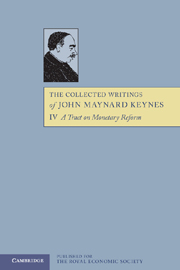Book contents
- Frontmatter
- Contents
- General Introduction
- Note to the reader
- Preface
- Preface to the French Edition
- 1 THE CONSEQUENCES TO SOCIETY OF CHANGES IN THE VALUE OF MONEY
- 2 PUBLIC FINANCE AND CHANGES IN THE VALUE OF MONEY
- 3 THE THEORY OF MONEY AND THE EXCHANGES
- 4 ALTERNATIVE AIMS IN MONETARY POLICY
- 5 POSITIVE SUGGESTIONS FOR THE FUTURE REGULATION OF MONEY
- Appendix I
- Appendix II
- Appendix III
- Index
Appendix II
Published online by Cambridge University Press: 05 November 2012
- Frontmatter
- Contents
- General Introduction
- Note to the reader
- Preface
- Preface to the French Edition
- 1 THE CONSEQUENCES TO SOCIETY OF CHANGES IN THE VALUE OF MONEY
- 2 PUBLIC FINANCE AND CHANGES IN THE VALUE OF MONEY
- 3 THE THEORY OF MONEY AND THE EXCHANGES
- 4 ALTERNATIVE AIMS IN MONETARY POLICY
- 5 POSITIVE SUGGESTIONS FOR THE FUTURE REGULATION OF MONEY
- Appendix I
- Appendix II
- Appendix III
- Index
Summary
When it diverged greatly from the text on page 80 above, the original article ‘The Theory of the Exchanges and “Purchasing Power Parity“’ concluded as follows:
Thus a tendency of these two measures of the value of a country's currency to move differently is a highly interesting symptom; but it is not possible to say, without a further examination of each special case, of what exactly it is significant. Let me illustrate these theories by a brief examination of the actual figures charted below.
The first of these charts, which deals with the value of sterling, illustrates the significance of the choice of a base period. The top line, which gives the purchasing power parity calculated with 1913 as base, remains steadily above the actual exchange, but the second line, which is the same thing calculated with August 1919 as base, displays a persevering tendency to come together with the actual exchange, the line of which it is very frequently crossing. If we could depend on an inductive argument, it would be tempting to conclude from this chart that the events of the war have depressed the equilibrium of the purchasing power parity of sterling as against the dollar by about 6 per cent, but that with this adjustment the theory has worked very well indeed for the past two and a half years.
Information
- Type
- Chapter
- Information
- The Collected Writings of John Maynard Keynes , pp. 164 - 169Publisher: Royal Economic SocietyPrint publication year: 1978
Accessibility standard: Unknown
Why this information is here
This section outlines the accessibility features of this content - including support for screen readers, full keyboard navigation and high-contrast display options. This may not be relevant for you.Accessibility Information
- 1
- Cited by
